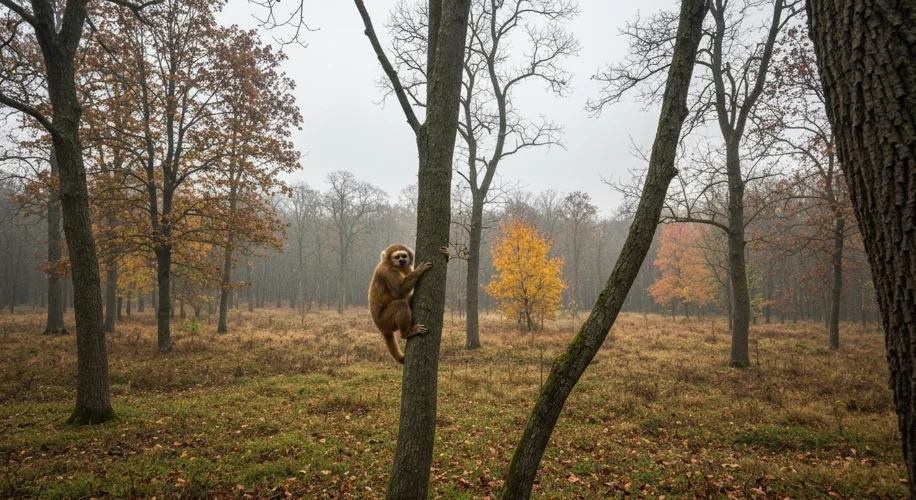For generations, our textbooks have painted a familiar picture: the earliest primates, our distant ancestors, were tropical creatures. They scampered through lush, warm forests, their lives dictated by the rhythm of sun-drenched leaves and humid air. This enduring image, deeply ingrained in our understanding of evolution, suggests that the warmth of the tropics was the cradle of primate life. But what if this comforting narrative is fundamentally flawed? What if the story of our origins is far colder, far more challenging, and far more surprising than we ever imagined?
Recent discoveries have begun to chip away at this long-held belief, presenting a compelling alternative. The tale begins not in the steamy jungles of Africa or Asia, but in the temperate, and perhaps even frigid, landscapes of what is now Europe and North America. Imagine a world vastly different from our modern perception of primate habitats. Instead of dense, humid rainforests, picture ancient forests blanketed in snow during harsh winters, with deciduous trees shedding their leaves to reveal stark, open landscapes. This is the challenging environment that a growing body of fossil evidence suggests our earliest primate ancestors may have called home.
The paradigm shift is largely driven by discoveries made in regions that are now considered temperate, even cold. For decades, paleontologists unearthed primate fossils primarily from warmer, subtropical deposits. This led to a straightforward conclusion: primates evolved in the tropics. However, meticulous re-examination of these fossils, alongside entirely new finds, has begun to paint a different picture. For instance, fossils of early primates have been found in Paleocene and Eocene deposits in places like Europe and North America, geological periods roughly 66 to 34 million years ago.

These ancient environments, while certainly not the frozen wastes of the Arctic, were significantly cooler and more seasonal than the tropical havens often depicted. Some of these regions experienced cold winters, necessitating adaptations for survival. The very nature of these fossils—their skeletal structures, their teeth, and their geographic distribution—suggests an animal that was not exclusively adapted to year-round warmth. Think of the differences between a modern lemur, thriving in Madagascar’s warm climate, and a tarsier, with its remarkable adaptations for a more varied, though still warm, environment. Now, imagine an ancestor that perhaps needed even more robust adaptations for cooler conditions.
Key players in this evolving understanding include the fossils of early plesiadapiforms and euprimates. Plesiadapiforms, often considered early relatives or perhaps even ancestors of true primates, have been found in deposits dating back to the Paleocene epoch. While their exact placement on the primate family tree is debated, their presence in cooler, more northerly latitudes is significant. Then came the euprimates, the earliest true primates, appearing in the Eocene. Their fossils, too, have been unearthed in strata that indicate a broader geographic range, extending into cooler temperate zones.
What does this mean for our understanding of primate evolution? It suggests that the selective pressures faced by our ancient ancestors were different from what was previously assumed. Instead of simply adapting to exploit the abundant resources of a tropical paradise, early primates may have had to contend with fluctuating temperatures, seasonal food scarcity, and the need for specialized survival strategies. This could include developing adaptations for burrowing, for navigating colder weather, or for utilizing a wider range of food sources available across different seasons.
This revised perspective has profound implications. If early primates evolved in more challenging, temperate climates, it reframes the entire narrative of their diversification and eventual global spread. It suggests a greater resilience and adaptability from the outset. Perhaps the ability to tolerate cooler conditions and seasonal variability was a crucial factor in the subsequent success and expansion of primates into diverse environments across the globe.
Moreover, understanding our primate origins in a colder context could offer new insights into early human evolution. While humans are far removed from these earliest primate ancestors, the foundational adaptations laid down millions of years ago might have played a role in the long-term evolutionary trajectory. The ability to adapt to changing environments, a hallmark of human success, might have deeper roots than we previously acknowledged.
The story of primate evolution is far from settled. Each new fossil discovery, each refined analysis, has the potential to rewrite chapters of our past. The idea that our lineage may have first taken root in cooler climes is a compelling challenge to traditional views, urging us to reconsider the very environmental cradles that shaped us. It’s a reminder that the grand narrative of life on Earth is constantly being unearthed, one fossil, one discovery, one cold, ancient forest at a time, revealing a past that is as complex and surprising as it is foundational to our present.

